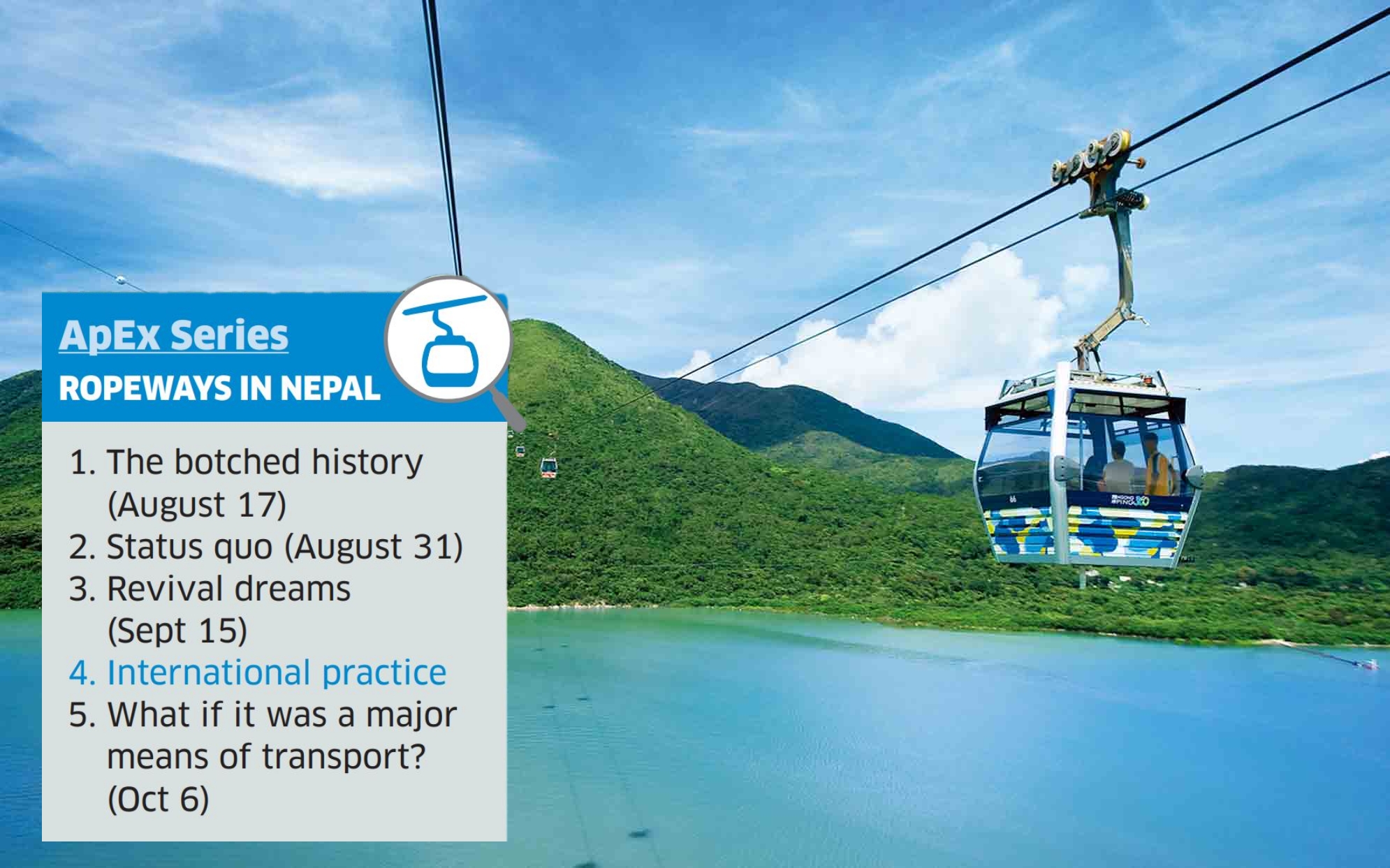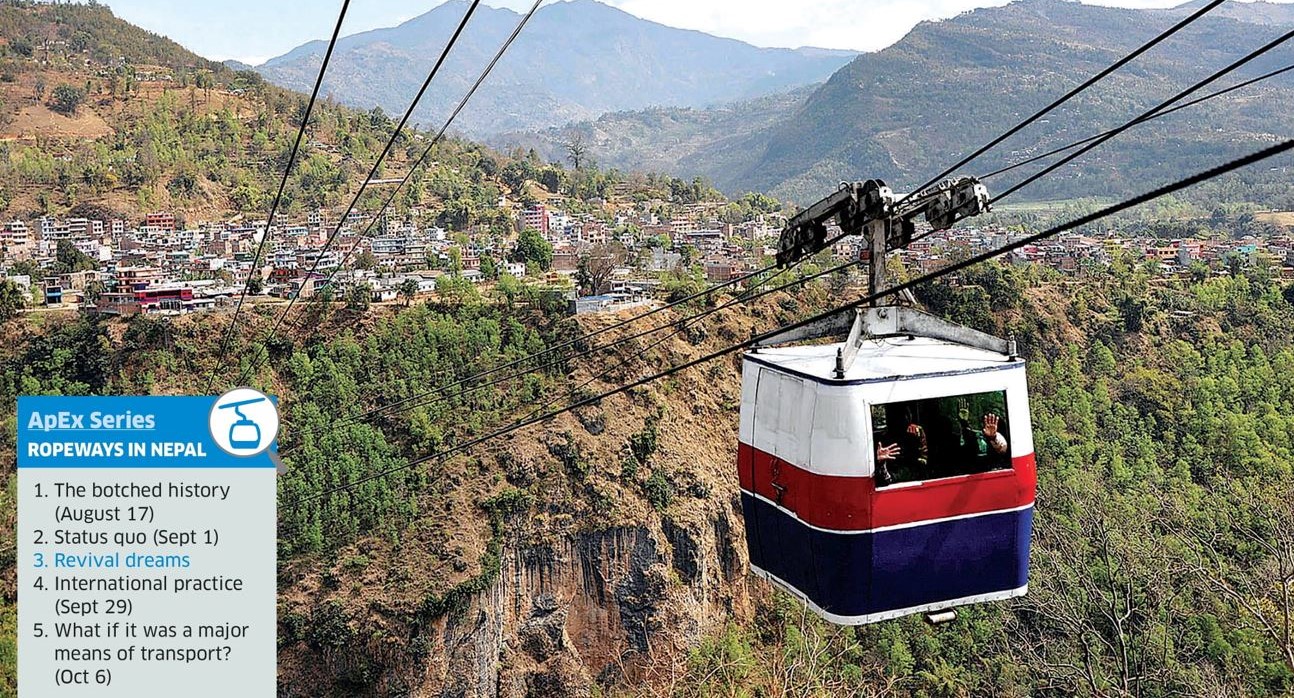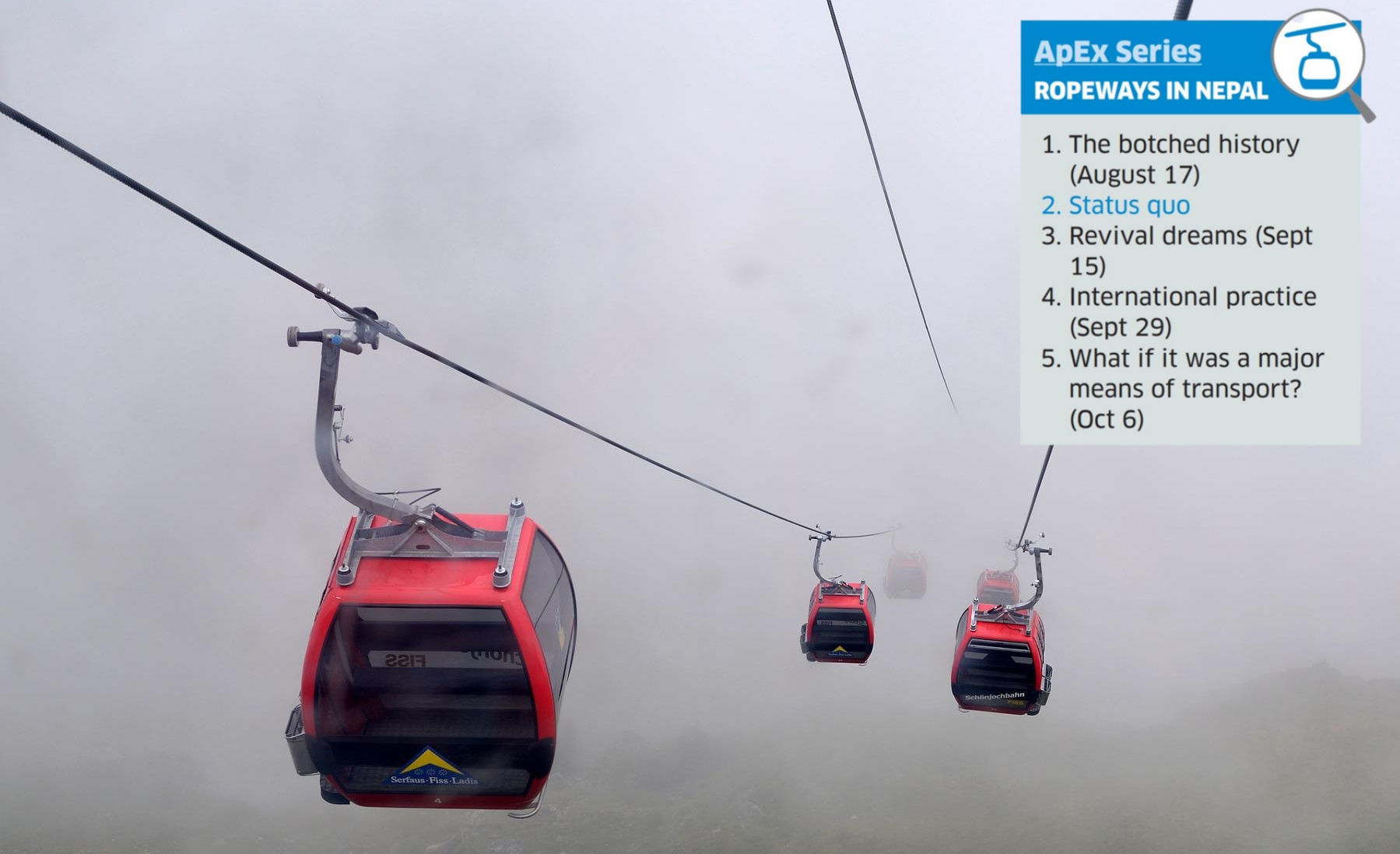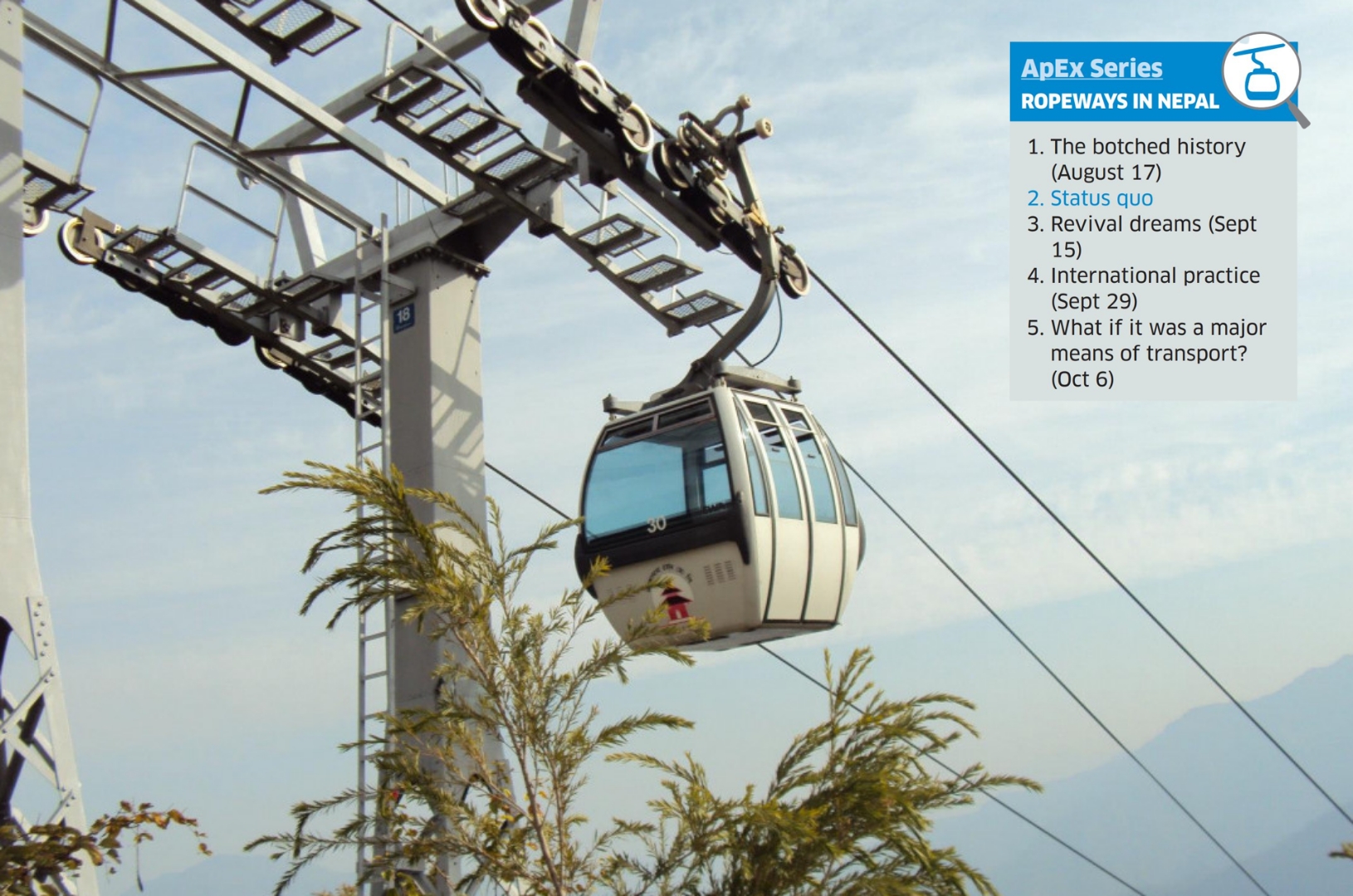ApEx Series | A case of clashing egos, unclear roles
In their first five-year tenure, local governments came into limelight for both good and bad reasons. Among the most prominent issues to hinder their functioning were disputes between chiefs and their deputies.
After the last local elections in 2017, women secured 91 percent of the deputy positions—deputy mayors in municipalities and vice-chairpersons in rural municipalities—while men bagged 98 percent of chief positions. This gender disparity certainly contributed to many disputes but there were plenty of other factors as well.
Different places had different root causes of disputes between the chiefs and their deputies. The local units with the chiefs and deputies from separate parties saw most disputes, as they jostled for influence.
Similarly, many places saw an unhealthy competition to take credit for development projects, as each tried to allocate more funds for his or her own constituency. In a classic case, Kathmandu Metropolitan City’s mayor Bidhya Sundar Shakya from CPN-UML famously clashed with deputy mayor Hari Prabha Khadgi from Nepali Congress.
They never had cordial relations. In April 2019, Mayor Shakya accused his deputy of deferring action against the traders who had allegedly encroached on Khulamanch, an open space in Kathmandu. A war of words ensued. Earlier, in 2018, the two had publicly clashed over Ranipokhari reconstruction.
In comparison, the local bodies with both heads and deputies from the same party saw fewer clashes. In Kavrepalnchowk district, all local bodies had chiefs and deputy chiefs from the same parties. “We have seen reports of clashes between the two executives in dozens of local governments but in our district there is relative harmony,” says Udhav KC, chief of the district coordination committee.
There is also a lack of clarity on individual roles and responsibilities. The Local Government Operation Act 2017 provides for many overlapping responsibilities, inviting interference in each other’s jurisdiction.
For instance, the deputy chairs a three-member Judicial Committee that is mandated to settle local-level disputes. But the chiefs have tended to poke their noses into such cases, as they feel entitled to do so.
Moreover, there is a sizable section of chiefs who believe the post of deputies is largely ceremonial as it is they who exercise all executive powers in municipalities and rural municipalities.
In fact, most duties of deputies are related to monitoring, supervision, and work-facilitation, with he or she getting to enjoy executive rights only in the absence of the chief.
Bansalal Tamang, general secretary, National Association of Rural Municipalities, says there have been efforts to clarify the jurisdictions of chiefs and deputies through orientation programs. “Initially, there was a lot of tussle. But with greater clarity over individual jurisdictions, most local-level disputes these days tend to be political,” he says.
There have also been instances of the male chiefs questioning their female deputies’ work and education credentials. The Act envisions voluntary transfer of some power from the chiefs to his deputies but that is hardly happening.
In some other places, there have been disputes when the deputies asked for the same kind of facilities that the chiefs were getting.
The local bodies in (now) Madhes province saw most tussles between chiefs and deputies, as they were invariably from different parties. Prabhakar Yadav, Chief of District Coordination Committee Saptari, gives the example of the Chhinnamast Rural Municipality, where the municipal council has not sat in two years due to the internecine disputes between the chief and deputy.
Speaking to ApEx, vice-chair of Chhinnamasta Rural Municipality Usha Kumar Mandal confessed to her long-standing problems with chair Surya Naryan Mandal. “Our development projects and service-delivery have been badly affected due to the chair’s monopoly, and it is difficult for me to work as vice-chair,” she says.
There have been similar cases in local governments of Rautahat district. In Yamunamai Rural Municipality, the tussle between chief Shree Prasad Machida and deputy Gita Devi Sah has for years crippled the rural municipality’s functioning.
There are no mechanisms to look into the disputes between the chiefs and the deputies. This is one issue that must be resolved ahead of the next local elections. But till date the federal government seems noncommittal. Journalist Gita Chimoriya, who closely tracks local level disputes across the country, speaks of the urgent need to set up a mechanism that closely and continuously monitors such disputes and offers solutions.
“In the course of my study of local bodies, I have come across instances of nasty disputes. In some places, the chiefs and deputies do not even speak to each other,” says Chimoriya.
Basanta Adhikari, spokesperson at the Ministry of Federal Affairs and General Administration, says resolution of such disputes falls under the jurisdiction of provincial governments, not the federal government.
Major duties of chiefs
· Organizing and leading the meeting of the municipal executive committee
· Presenting and endorsing the list of agenda in all meetings
· Preparing annual budget and program
· Calling the meeting of Municipal Assembly
· Overseeing and monitoring day-to-day functioning
(The chief has 12 major ‘concrete’ responsibilities)
Major duties of deputy
· Coordinator of Judicial Committee
· Coordination of programs related to non-governmental organizations
· Coordination of activities related to consumer welfare
· Monitoring, supervising, and reporting local government’s programs
· Member of local resource estimation and budget ceiling determination committee
(Deputy has eight, mostly ill-defined responsibilities)
Source: Local government operation Act 2017
‘ApEx for climate’ Series | Money to adapt to climate change simply not there
At the United Nations, Nepal has presented an ambitious plan of achieving net-zero carbon emission by 2045. In addition, it has pledged before the international community that, come 2030, 15 percent of its total energy will come from clean sources and 45 percent of the country’s forest cover will be maintained.
These targets can only be achieved if the Nepal government secures sufficient funds for its adaptation and mitigation measures. That is why Nepal has made it clear that its climate commitments are contingent on funds from international organizations.
At the recent COP26 summit in Glasgow, Scotland, Prime Minister Sher Bahadur Deuba was clear that Nepal could deliver on its goals “only through quick, direct, and easy access to climate finance”. The country thus urged the international community to agree on a clear roadmap for a new collective, quantified and ambitious goal on climate finance before 2025.
After the finalization of the climate change budget code in 2012 in order to track allocations to climate change related projects and programs, the Nepal government has since 2013 set aside money under ‘climate change’ in its annual budget.
In addition, Nepal has been lobbying for funds from various bilateral and multilateral organizations to implement adaptation and mitigation measures and reportedly, it is already getting ‘millions of dollars’ even though exact figures are hard to come by. But there is a lack of transparency in the climate budget. Irrespective of the budgetary provisions, in the absence of dedicated mechanisms, it has been hard to track income and expenditure.
Also read: ‘ApEx for climate’ Series | Nepal makes its case. But to what effect?
There is a related problem as well. Even though both government and non-government agencies are implementing dozens of programs to address climate and environmental issues, it is difficult to isolate expenditure on climate issues in the absence of an exact definition of ‘climate expense’.
Says climate change watcher Manjeet Dhakal, money is being spent in specific areas of climate change but also on other indirectly linked areas. For instance, a few years ago, the government had allocated Rs 3 billion for the purchase of electric vehicles with the goal of reducing the emission of greenhouse gasses, says Dhakal.According to him, even though the Ministry of Forest and Environment is the focal ministry, other government agencies are also allocating budgets on climate-related issues. Compared to the past, there is greater awareness on climate change in government agencies, and thus also on the need to allocate budget for it. In addition, government agencies are starting to adopt sustainable development models.
But current budgetary allocations are not sufficient to achieve net-zero by 2045, which the government aims to do by increasing the use of renewable energy.
Nepal submitted its second Nationally Determined Contribution (NDC) to the United Nations under the Paris Agreement. In the NDC, Nepal has committed to a slew of measures to reduce carbon emissions and launch adaptation and mitigation actions. An estimated $25 billion is required to meet the targets—and hence the conditional clause in the NDC.
Also read: ‘ApEx for climate’ Series | Nepal in the middle of a climate crisis
To get support, the Fifteenth Plan (2019-2024) talks about ‘advocating at the international level for easy access to climate finance and distributing any potential benefits to provincial, local, and community levels.’
Similarly, the Climate Change Policy introduced in 2019 states that “national resources will be identified for the implementation of climate change-related policies, and all resources will be mobilized in a just manner by increasing access to bilateral, multilateral, and international financial resources pertaining thereto.”
Climate finance involves many actors and agencies like government bodies, development partners, UN agencies, multilateral development banks, I/NGOs, local institutions, corporate houses, and user groups.
Specifically, Nepal can get financial support from multilateral international financial mechanisms such as REDD+, Green Climate Fund, Global Environment Facility, Adaptation Fund, Climate Investment Fund, and Carbon Trade. Similarly, it can and has been getting funds through various bilateral mechanisms in sectors like agriculture and forest.
“The private sector actors for their part can invest in climate via initiatives under their corporate social responsibility,” says Dhakal.
Also read: ‘ApEx for climate’ Series | How does Nepal get help in tackling climate change?
But at the end of the day Nepal and other LDCs will have sufficient money for climate action only if developed countries fulfill their commitments. In the Copenhagen Accord signed in 2009, developed countries pledged approximately $100 billion by 2020, which was not delivered. The Paris Agreement 2015 reaffirmed the commitment, but also to no avail.The Paris Accord says, “As part of a global effort, developed country Parties should continue to take the lead in mobilizing climate finance from a wide variety of sources, instruments, and channels, noting the significant role of public funds, through a variety of actions, including supporting country-driven strategies and taking into account the needs and priorities of developing country Parties. Such mobilization of climate finance should represent a progression beyond previous efforts.”
At COP26, developed countries again pledged to meet the old target by 2023.
Nepal’s own budgetary allocation for climate has been steadily increasing, and today all three levels of government have yearly climate budgets.
There is also a question over how the three tiers of government are spending their climate funds. The country’s climate change policy provisions for mobilization of 80 percent budget for local-level climate programs by reducing administrative expenses. The policy also states that there will be appropriation of the budget for women, minorities, backward class, climate change affected areas and vulnerable communities.
Yet a large portion of the climate budget, say the critics of the current arrangement, is being spent on meetings and seminars in Kathmandu rather than on the ground. “For our climate initiatives to be effective, around 80 percent of the climate budget should be spent at the local level,” says climate journalist Mukesh Pokhrel. “But a far smaller share goes to local bodies right now.”
Also read: ‘ApEx for climate’ Series | Putting Nepal’s gen-next in climate lead
The federal government in Nepal appropriates 60 percent of the total budget while local governments get only 20 percent. The provincial governments, for their part, get 12 percent.Nepal has pledged with the international community to formulate climate finance strategy and national capacity on climate finance management by 2022. Homework on this has begun but progress has been patchy. Till date, there is no mechanism in Nepal to exclusively handle climate finance. There is a separate ‘climate change’ division under the Ministry of Forest and Environment but experts say a separate body is needed to coordinate with other government agencies.
In recent years, the government has launched some specific programs targeting climate change. In 2021/22, the Nepal government launched a carbon emissions reduction program in 13 districts of Tarai Madhes including Rautahat, Bara, Parsa, Chitwan, Banke, Bardiya, Kailali, and Kanchanpur.
In the fiscal year 2020/2021, it started research programs on forest, plant resources, wildlife, biodiversity, watershed, environment, and climate change in coordination and partnership with universities and research institutions.
More than that, there is a need to decentralize the climate budget and take it to the grassroots where the most adverse effects of climate change are felt. At the same time, local governments should be empowered to deal with climate change issues. “But most of the money is being spent in administrative and non-productive areas. There should be a thorough review of what we are doing,” advises Pokhrel.
Nepal’s priorities don’t match the donors’
Ram Chandra Bhattarai, Economist
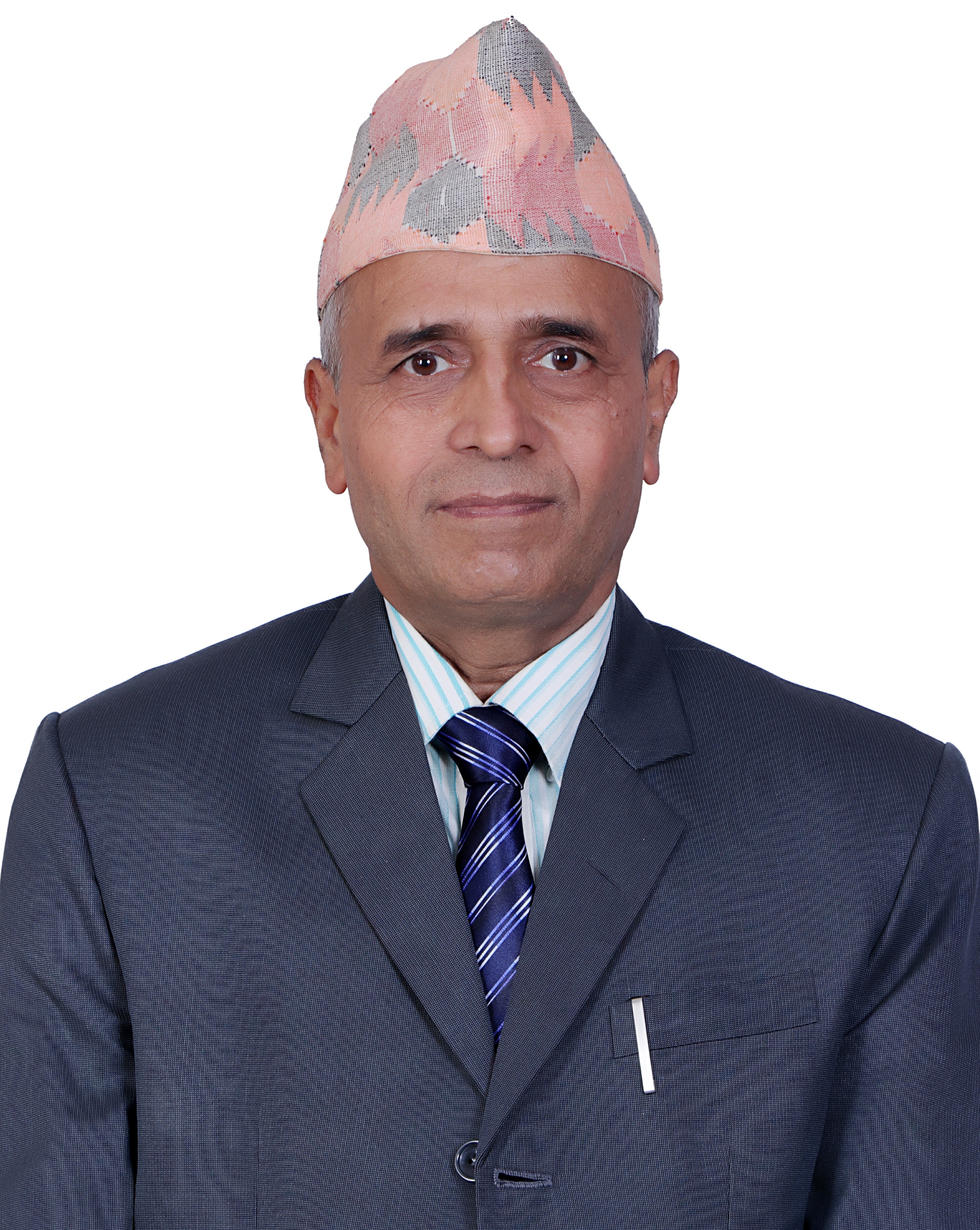
We are spending less than three percent of our Gross Domestic Product (GDP) in the climate sector. Climate finance is basically what donors give us. It is donor-guided and as such their interests prevail. We basically need finance for our adaptation measures.
We are more responsible for adaptation than mitigation. Nepal does not contribute to climate change but faces most of the related problems. Yet there is little international support on adaptation. We are doing adaptation mostly on our own; most of the help we get from abroad goes into mitigation, which is the donors’ interest.
Donors are investing in alternative energy but that is not our number one priority right now. They are not providing pure climate finance—just transferring money already allocated to other sectors.
We are making a lot of noise on climate change and climate finance but there has been little progress. Even our usual expenditure has been clubbed under ‘climate change initiatives’. For example, the money we are spending on the preservation of our forests. When it comes to actual spending on climate change, there is little of it.
Five questions to Manjeet Dhakal
Achieving net-zero emission is not difficult for Nepal
Though Nepal is recognized as one of the most vulnerable countries to climate change, there is little in terms of preparation for a possible climate crisis, or in mitigation measures. How can we be better prepared? And do we have the money and other resources to pursue climate initiatives? Pratik Ghimire of ApEx talked to Manjeet Dhakal, a student of climate change who is also the Head of the LDC Support Team at Climate Analytics.
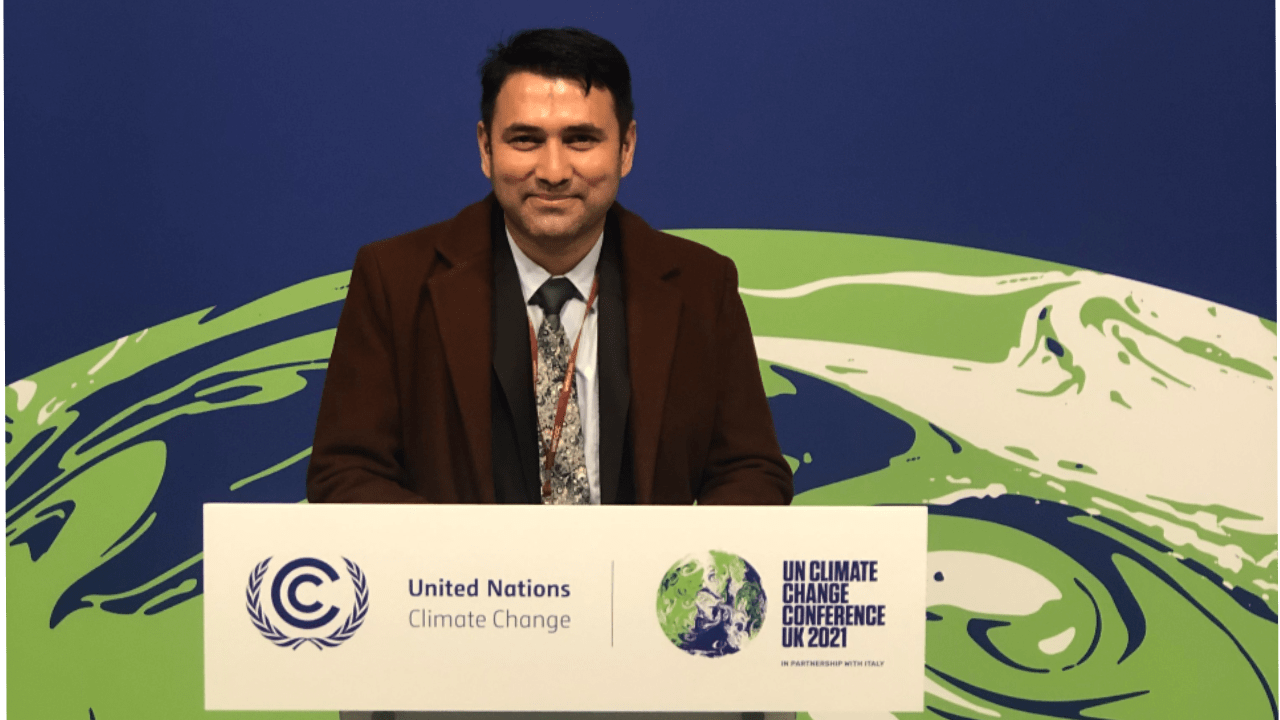
What is the current status of the effects of climate change in Nepal?
Many reports have suggested that Nepal is highly vulnerable to climate change. This is also because temperatures here are increasing faster compared to other parts of the world. Erratic rainfall has destroyed our crops, leading to an agro-based job crisis. Moreover, climate change has caused floods and other disasters, and destroyed vital infrastructures like the Melamchi Water Project. This has put added strain on our already stretched economy. Effects of climate change also depend on a country’s economic status. Well-off countries can take up measures to build resilience. As we can’t afford that we are forced to bear the brunt of climate change.
Can Nepal achieve net-zero emissions by 2045 as promised at COP26?
I don’t think it is going to be difficult as there has been a massive development in climate technologies. We now can, for instance, switch to electric vehicles instead of petrol and diesel ones. That would substantially reduce carbon emissions. As Nepal has only a handful of industrial sites, we can easily electrify the new factories. The government is aiming to increase forest cover to 45 percent of the land by 2030. Hopefully, the goal can be achieved. Nepal imports around Rs 200 billion worth of petroleum products a year. We can channel that money in the development of electric machinery instead.
How do you see Nepal’s climate diplomacy?
I find it progressive and reform-oriented as we are frequently invited to climate change-related international summits and given the chance to share our data and situation. That said, it is not easy for a small nation to maintain diplomatic relations, especially on climate issues, given our limited resources.
Also read: Bishal Nath Upreti: There is no quick fix to Kathmandu’s flooding
Is the international community turning a blind eye to our mountain agenda?
I don’t think so. If you go back to the recent COP26 summit, Prime Minister Sher Bahadur Deuba presented our agenda and the international community responded positively. There are some failed projects too. But we have to look at our mistakes first. They had shown an interest in Sagarmatha Sambad as well, but we couldn’t push it. The best thing that happened at COP26 is that we didn’t ask for help, we rather shared our initiation and progress. Prime Minister Deuba has committed to organizing Sagarmatha Sambad and let’s hope he means it.
Moreover, it is technically difficult to extract data from mountain regions, which might have been looked upon as ignorance. But it is the same for other nations who raise mountain agendas. We get a good response otherwise.
How can Nepal get enough climate finance for adaptation and mitigation?
We have to find international funding for that, and to an extent, we are getting that too. No nation provides funds easily, so we have to convince them with our vulnerability reports, data, commitments, obligations, and authentic process and progress. A decade ago, developed nations had pledged $100 billion annually to the least developed nations to fight the climate crisis. But the pledge has not been met. Yet, compared to others, we are among the countries that get good international funding on climate issues.
We can also do our bit by reducing the import of petroleum products and using the saved money as climate finance. By doing that, first, we will greatly reduce our trade deficit, and second, greater use of electric machinery will also help us clean up our environment. Separately, if we can cut down the import of petroleum products by only five percent, we can provide Covid-19 vaccines to every Nepali.
‘ApEx for climate’ Series | Putting Nepal’s gen-next in climate lead
When 15-year-old Swedish environmental activist Greta Thunberg protested outside the Swedish Parliament in 2018, holding a sign saying ‘School Strike for Climate’, few took her campaign seriously. But she continued to bunk school to raise climate change issues.
Three years on, 18-year-old Greta is now at the center of a global climate change campaign, which in turn is an inspiration for adolescents across the world. Only now have global political leaders started to heed the issues she raised and she has become a beacon of hope for the younger generations, hammering home the message that world leaders need to act to preserve the earth from the menace of climate change.
Back in 2019, United Nations Secretary-General, António Guterres, in a meeting with Greta, said, “My generation has largely failed until now to preserve both justices in the world and to preserve the planet. It is your generation that must make us accountable to make sure that we don't betray the future of humankind.”
The COP26 conference held in November 2021 in Glasgow, Scotland, recognized the youth as critical agents of change. Additionally, the conference encouraged governments around the world to include youths as a part of national delegations in climate conferences.
Some policy documents of the Nepal government have also recognized the youth’s role on climate change issues. Nepal’s climate change policy introduced in 2019 states that “youth human resources will be mobilized by developing their capacity for raising awareness about climate change.” The policy further says youth researchers will be encouraged in climate change-related research and studies. Moreover, it talks about forming and mobilizing youth volunteer committees for climate-induced disaster management.
Also read: ‘ApEx for climate’ Series | Nepal makes its case. But to what effect?
The Nationally Determined Contribution (NDC) presented by Nepal government in 2020 pledges to promote the leadership, participation, and negotiation capacity of women, indigenous peoples, and youth in climate change forums. The document talks about implementing the NDC through federal, provincial, and local governments, in collaboration with other relevant stakeholders including youth, women, and indigenous people.
International and national documents and frameworks have recognized the youth as an integral part of climate action. But what is the state of implementation? Are Nepali youths ready to contribute? What is the status of our youth’s participation in climate action?
According Radha Wagle, Joint secretary and head of Climate Division at the Ministry of Forest and Environment, youth involvement in climate-related policies and platforms is increasing but that is not enough. Wagle informs that four youths were inducted as members of the national delegation in the COP26 Summit. “We are also working on increasing the presence and contribution of youths in climate-related policy and implementation programs,” she adds.
Observers say young generations are not only at the receiving end of climate change but they can also play a vital role in addressing the issue. They can serve as agents of change and innovators in the action against climate. Over the past few decades, more and more youths are coming out to flag the issues of climate change.
Sagar Koirala, a youth climate activist, says the representation of Nepali youths in the climate change sector is low compared to other countries. “Only a few youths get to have their say in decision-making,” says Koirala. “No youth is consulted in major decision-making.” He says, as a youth climate activist, he wants to change this system and empower the youth. He stresses on the need for institutional mechanisms to empower a growing number of young people in climate action.
Also read: ‘ApEx for climate’ Series | Nepal in the middle of a climate crisis
At COP26, countries agreed to a new 10-year program of action on climate empowerment in order to promote youth engagement, climate education, and public participation. At the national level as well, the government should have policies to engage youths in all climate-related activities.
A few weeks back, ApEx had surveyed a random group of youths to gauge the level of their awareness about climate change. They had only a basic understanding of the issue.
In Nepal, youths began a systematic campaign on climate change only after 2008. There are now organizations advocating youth’s participation in climate action. For instance, the Nepalese Youth for Climate Action (NYCA), a youth-led coalition of the Nepali youths tackling climate change, was established in 2008 with a motto of ‘caring for climate change, caring for ourselves’. It has networks in various parts of the country.
Program Coordinator at Clean Energy Nepal, Lal Mani Wagle, who has worked as a youth climate activist, says there is much awareness on climate change among youths, at least in urban areas, compared to other areas of the environment. He says the government has recognized the youths who are working on climate change. “We can say youths have been contributing to climate action over the past decade,” says Wagle. “However, we are yet to systematize youth contributions in policy- and decision-making levels. It is a matter of satisfaction that government agencies are heeding youth suggestions.”
COP26 was not youth-inclusive
Prakriti Koirala

It had always been an ambition of mine to attend the Conference of Parties (COP) summit. Since elementary school, I had heard of the conference, procedures, and agreements. This year I got a chance to attend the COP26 in Glasgow, Scotland. I was lucky to have a party badge that allowed me access to all secret meetings.
From the perspective of a young person, the conference was not as youth-inclusive as we had expected. Fortunately, the participants representing the Nepali Ministry, CSOs, INGOs, NGOs, and youths as a whole worked well together. Nepali youths with party badges had the opportunity to participate in negotiations, while those with observer badges took part in various side events, sharing sessions, and the climate strike.
In my observation, youths from other countries, particularly in Africa, were leading their teams. They were in charge of preparing the drafts, negotiating with foreign governments, and attending various bilateral meetings. This impressed me and encouraged me to be well prepared, and made me realize that we as youths still have a lot of work. At the national level, many policies have addressed the voice of youths. However, we still have a long way to go in terms of involving youngsters in all aspects of climate change discussions and decision-making.
Koirala is a young climate activist
Youths are the most vulnerable group
Umesh Balal Magar

Climate change is an intergenerational problem caused by humans, mainly from the developed countries, and there is no silver bullet. Experts also say there is no science to cure the climate change problem but what we can certainly do is guide human behavior towards a more sustainable lifestyle.
Lack of political will is the main cause of climate change. Countries around the world are reluctant to implement solutions to combat the effects of climate change as they are too occupied with the goal of economic development, thereby increasing the emission of greenhouse gasses. That is exactly why we have failed for the 26th time to agree on a global solution at COP.
Also read: ‘ApEx for climate’ Series | How does Nepal get help in tackling climate change?
Nepal is one of the most vulnerable countries to climate change despite its small contribution to global CO2 emission. It has done some remarkable work on climate change mitigation policies. At COP26 in Glasgow, we stood firm in our commitment to net-zero emission and have prepared an exemplary NDC to remain steadfast towards that end.
Youths are the most vulnerable to climate change. In Nepal, we face all kinds of disaster threats like glacier lake outbursts, landslides and floods. Though youths are on the frontline of disasters, they are unlikely to make it to the policy-making table.
The Nepalese Youth for Climate Action (NYCA), a group of youth from all over the country, is working to protect Nepal and the Nepali people from adverse impacts of climate change by spreading awareness, advocating policies and taking action. We have been playing a key role in making Nepal more climate-resilient by leading adaptation efforts and through mitigation of GHGs since 2008. We work from local, national and international platforms for youth climate justice.
Magar is network coordinator, Nepalese Youth for Climate Action (NYCA)
‘ApEx for climate’ Series | How does Nepal get help in tackling climate change?
As we reported two weeks ago, the effects of climate change are real and already visible in various sectors. Some mitigation and adaptation programs have been initiated but there is an urgent need to ramp them up.
As Nepal alone can’t fight the effects of climate change with its limited resources and knowledge, it needs to secure international support and cooperation. There is a need to build a wide international network through robust diplomacy, which in turn must focus on securing resources to gain access to the latest available technology, all in order to deal with climate-induced disasters.
So, the issue of climate change should be an integral part of the country’s engagement at bilateral, regional, and multilateral levels. However, except for participating in international platforms, Nepali diplomats don’t prominently raise the issue—the Ministry of Foreign Affairs doesn’t even have a mechanism dedicated to climate diplomacy.
In addition, seldom do the Ministry of Forest and Environment, the Ministry of Foreign Affairs, and the Ministry of Finance cooperate on climate change issues.
But politicians and bureaucrats are gradually starting to realize that climate should be a focal component of foreign policy.
Prabhu Budathoki, former member of the National Planning Commission (NPC) and a student of climate change, says there is a need for a nodal agency to deal with climate-related issues, both in and outside the country. “When I was an NPC member in 2017, I had lobbied for the creation of such an entity within the NPC to coordinate with all government agencies,” says Budhathoki. “Given the urgency of the matter, big countries have already started to appoint climate envoys, but we don’t even have a focal agency.”
Also read: ‘ApEx for climate’ Series | Nepal makes its case. But to what effect?
For the first time, Nepal’s foreign policy unveiled in 2020 incorporated a separate section on climate diplomacy. The policy envisioned Nepal’s proactive role in the policy formulation process of the United Nations and other international platforms for the acquisition of resources and technology for mitigation and adaptation plans. It also says Nepal shall lead mountainous countries to implement the principle of ‘polluters-pay’.
But, a key challenge, like always, is implementation. First, the Deuba government has not owned the policy introduced by the erstwhile KP Sharma Oli administration. New Foreign Minister Narayan Khadka publicly says he has initiated consultations to draft a new foreign policy.
To highlight Nepal’s issues and build an international network, the erstwhile government had initiated the Sagarmatha Sambad, a flagship annual international program to highlight Nepal’s agenda, including climate change. The event was planned for 2020 and a separate mechanism was set up for the same purpose—before it was postponed due to the Covid-19 pandemic.
After the easing of international travel, the Oli-led government had organized a conference just before the UN Framework Convention on Climate Change COP-26 to highlight Nepal’s agenda. But then the government changed.
Bimala Rai Paudyal, member of the National Assembly, who closely worked in the preparations of Sagarmatha Sambaad, says the current government has not owned up the initiatives of the previous government. Paudyal says the key purpose of such a dialogue was to invite world leaders to discuss pressing global issues and identity Nepal’s stand. “We had planned to hold the first dialogue on climate change to highlight the global climate issues as well as their effects on Nepal,” she says. The Nepal government had already invested millions in preparations and some invitations were also sent.
At COP-26, Prime Minister Sher Bahadur Deuba committed to holding the summit, too, but to no avail.
Also read: ‘ApEx for climate’ Series | Nepal in the middle of a climate crisis
But Nepal should step up its diplomatic efforts, most vitally in carbon trade. Nepal’s forests store over 500 million tonnes of carbon and it is eligible to sell carbon credits to developed countries that want to offset their emissions.
The ‘mountain agenda’ is also not getting due attention in climate-related international negotiations. Though Nepal repeatedly urges the world to recognize specific climate vulnerabilities of high mountains, it has not been given priority in international policy frameworks.
Nepal has committed to achieving net-zero emission by 2045—a move estimated to cost $25 billion. Most targets set by Nepal are conditional: it can achieve them only with international support. But as Nepal graduates from the list of Least Developed Countries bloc, it will face additional hurdles in getting international support for its mitigation programs.
It is not only about finance. Nepal also needs to secure technological means and knowledge on capacity-building. The Green Climate Fund, Global Environment Facility, and Adaptation Fund are the potential fund sources . Similarly, there are bilateral/multilateral agencies and development partners before whom Nepal will have to display its capability to secure funds.
Issues related to loss and damage remain a key concern for Nepal. Addressing the COP26 Summit, Prime Minister Deuba said, “Loss and damage have become a key concern due to increased phenomena of climate-induced disasters. This subject must find a place under article 4.8 of the Convention. We call upon the Parties to agree on making Loss and Damage a stand-alone agenda for negotiations and support the framework of additional financing for it.”
Also read: Nepal’s COP26 commitments
Now, Nepal is raising this issue through the Least Developed Countries (LDC) group on climate change. The Least Developed Countries are 46 nations that are especially vulnerable to climate change but have contributed the least to the phenomena.
Similarly, Nepal is a member of the G-77 group on climate change issues. Activist Arjun Dhakal says Nepal’s climate diplomacy through the LDC group and G-77 is not yielding results. Instead of only relying on these platforms, says Dhakal, Nepal should start leading the climate change dialogue.
“For instance, we can lead the mountain agenda by bringing all mountainous countries, including India and China, on board,” says Dhakal. Dhakal also advocates for the formation of a separate entity to deal with climate diplomacy.
“We can create a separate mechanism under the Prime Minister’s Office by incorporating climate change experts and other technical manpower,” he says. Nepal needs to deal with major powers like the United States, United Kingdom, China, and other countries to secure their support.
Regional organizations such as SAARC and BIMSTEC could also play an instrumental role in highlighting Nepal’s agenda both regionally and globally. The problem is that the two organizations are now largely dysfunctional.
During the 18th SAARC summit in Kathmandu in 2014, member countries had discussed climate change. The declaration document says, “They [top executives of member countries] directed the relevant bodies/mechanisms for effective implementation of SAARC Agreement on Rapid Response to Natural Disasters, SAARC Convention on Cooperation on Environment and Thimphu Statement on Climate Change, including taking into account the existential threats posed by climate change to some SAARC member states.”
Yet again, the problem was in the implementation of the agreed goals.
Sagarmatha Sambaad: What and when?
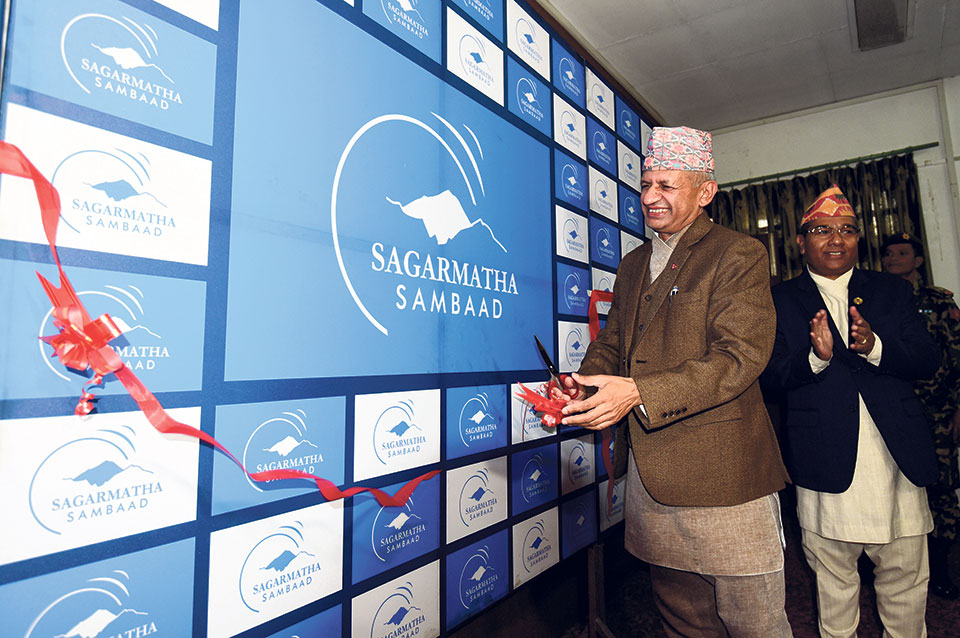
The then foreign minister Pradip Gyawali inaugurating the office of Sagarmatha Sambaad on 22 November 2019 | Photo: Sagarmathasambaad.org
Sagarmatha Sambaad is a multi-stakeholder dialogue forum envisioned by the erstwhile KP Oli government to discuss issues of global, regional, and national significance. As a platform, it aims to bring together people from across the globe to shave and drive the discourses for positive change.
The Oli government had planned to organize this flagship program every two years by inviting heads of state/government, parliamentarians, policymakers, and local government representatives, as well as leaders from intergovernmental organizations, private sector, civil society, think tanks, academia, women, youths, and media to discuss ways of cooperation, exchange of ideas and sharing of experiences on prominent global issues.
The first edition of the program, scheduled for 2-4 April 2020 on the theme of ‘Climate Change, Mountains and the Future of Humanity’, was indefinitely postponed due to the Covid-19 pandemic. After the easing of Covid-19 restrictions, the erstwhile Oli government had made preparations to organize a ‘hybrid program’ (part-online, part-live). But the government fell and the dialogue was not a priority of the new Deuba government. According to sources at the Ministry of Foreign Affairs, new Foreign Minister Narayan Khadka has been mum on the event.
Says Bimala Rai Paudyal, a member of the federal upper house who had worked in the preparations of the Sambaad, invitations were sent to dozens of heads of government and leaders. “As the new government did not follow through on our initiative, our resources have gone to waste and our international standing has been compromised,” she says.
















